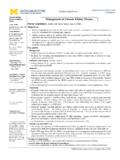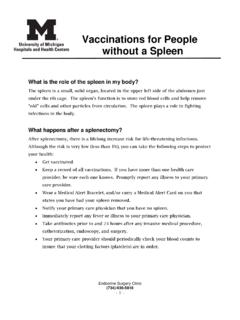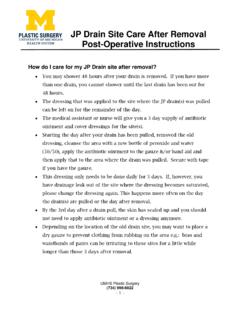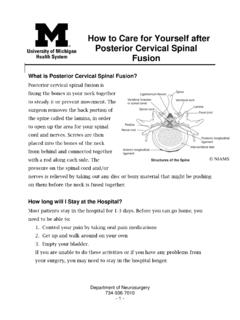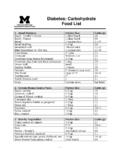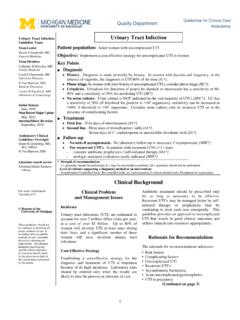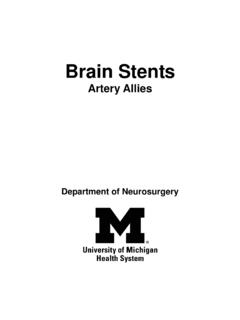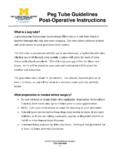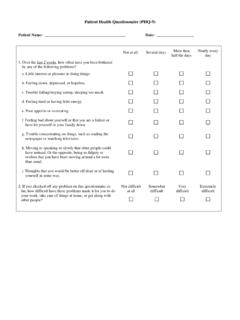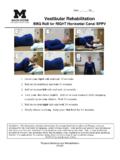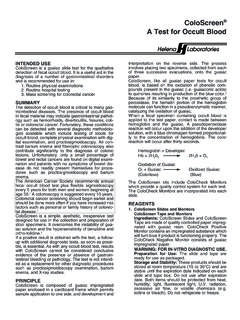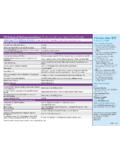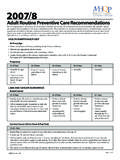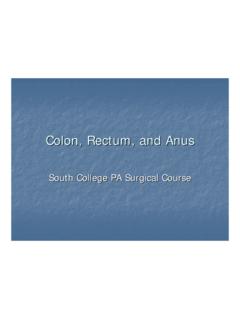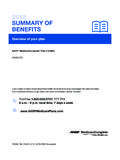Transcription of Adult Cancer Screening Cancer Screening - …
1 Quality Department Guidelines for Clinical Care Ambulatory Adult Cancer Screening Guideline Team: Breast Screening Connie J Standiford, MD General Medicine Cervical Screening Uche D George-Nwogu, MD Family Medicine Colorectal Screening Sandeep Vijan, MD General Medicine Prostate Screening Karl T Rew, MD Family Medicine R Van Harrison, PhD Medical Education Consultants: Barbara S. Apgar MD Family Medicine Daniel F Hayes, MD Breast Oncology Mark A Helvie, MD Breast Radiology James E Montie, MD Urology Anthony W Opipari, MD Obstetrics and Gynecology Mack T Ruffin IV, MD Family Medicine Philip S Schoenfeld, MD Gastroenterology Initial Release May, 2004 Most Recent Major Update December, 2011 Interim/Minor Revisions December 2014 Ambulatory Clinical Guidelines Oversight Connie J Standiford, MD Grant Greenberg, MD, MA, MHSA R Van Harrison.
2 PhD Literature search service Taubman Health Sciences Library For more information 734-936-9771 Regents of the University of Michigan These guidelines should not be construed as including all proper methods of care or excluding other acceptable methods of care reasonably directed to obtaining the same results. The ultimate judgment regarding any specific clinical procedure or treatment must be made by the physician in light of the circumstances presented by the patient. Cancer Screening Population: adults , 18 years and older Objectives: Implement an evidenced-based strategy for Screening adults for cancers of the breast, cervix, colon, and prostate. Key Points Breast Cancer Screening Modalities. Mammography with or without clinical breast exam. Current controversies.
3 Whether to screen women ages 40-49. Initiate. Average risk. Routine Screening mammography should be offered to women ages 50-74 [I A*]. For women ages 40-49, two nationally recognized recommendations are: The American Cancer Society (ACS) and the National Comprehensive Cancer Network (NCCN) recommend beginning Screening at age 40 years for average-risk women [II B]. US Preventive Services Task Force (USPSTF) recommends that beginning Screening before the age of 50 years should be an individual decision that takes patient context into account, including the patient's values regarding specific benefits and harms. For women ages 40-49 use shared decision making, including a discussion of the potential benefits and risks of Screening mammography [I B].
4 High risk. Women at increased risk of breast Cancer may benefit from earlier Screening and discussion of risk reduction strategies (see Tables 2 3) [II B]. Frequency. For average-risk women, ACS and NCNN recommend Screening every year; USPSTF recommends Screening every two years [II C]. For high risk, see Table 3. Terminate. Consider continuing Screening over age 74 only if life expectancy > 10 years [IIB]. Cervical Cancer Screening Modalities. Liquid-based cervical cytology (ThinPrep ) and conventional Papanicolaou (Pap) smear of cervical cells are acceptable for Screening . Co-testing using a combination of cytology (Pap) and HPV DNA testing may be appropriate for women older than 30 years. Initiate. Start Screening at age 21[I B], including women who have received the HPV vaccine [1C].
5 Screening is not indicated for women who have undergone a total hysterectomy for benign indications and do not have a prior history of cervical Cancer or its precursors [III B]. Frequency. Average risk. In women aged: < 21 years, do not screen 21-29 years, cytology screen every 3 years. 30 years, screen either every 3 years with cytology or every 5 years with combination cytology and HPV testing. [1 B]. High risk. For women with initial concurrent HPV-positive and cytology-negative Screening results, HPV and cytology retesting is recommended in 12 months rather than immediate colposcopy [II D]. When available, HPV genotype-specific testing for HPV 16 or HPV 16/18 may be performed for women who are cytology negative and HPV-positive. For women treated for CIN 2 or CIN 3, if surveillance testing (usually cytology 6 months post treatment) is negative, regular Screening resumes, as for average-risk women [1 C].
6 More frequent Screening , usually annual cytology, with or without HPV testing, is recommended for women who are immunosuppressed, infected with human immunodeficiency virus (HIV), or were exposed to diethylstilbestrol (DES) in utero [IC]. Terminate. Discontinue Screening women past age 65 who are not at high risk for cervical Cancer and who have three consecutive negative cytology results or two consecutive negative co-tests within the 10 years before cessation of Screening , with the most recent test occurring within the past 5 years [1 C]. For women who have a history of CIN 2 or CIN 3, continue Screening for at least 20 years after initial post-treatment surveillance [1 C]. For other high-risk women, Screening continues until limited life expectancy no longer warrants [1 D].
7 Key Points continue onto next page Note: Appendix A graphically presents Cancer Screening intervals by patient age. * Strength of recommendation: I = generally should be performed; II = may be reasonable to perform; III = generally should not be performed. * Levels of evidence reflect the best available literature in support of an intervention or test: A= randomized controlled trials; B = controlled trials, no randomization; C = observational trials; D = opinion of expert panel 2 UMHS Cancer Screening Guideline, November 2011 Key Points, continued Colorectal Cancer Screening Modalities. Recommended modalities include: fecal occult -blood testing (including fecal immunohistochemical testing), flexible sigmoidoscopy, colonoscopy, or stool DNA test. (Digital rectal exam is not effective in Screening for colorectal Cancer .)
8 Current controversies. Newer technologies, such as CT colonography (virtual colonoscopy) are not yet fully validated or recommended for average-risk patients. Initiate. For asymptomatic patients. Average risk. Screening should begin at age 50 [IB]. High risk. Individuals at increased risk of colorectal Cancer should undergo more aggressive Screening . The age to begin Screening varies with the nature of the increased risk see Table 5 [IC]. Frequency. Average risk. Screen with one of the following. The frequency of Screening has not been fully evaluated in clinical trials. High-sensitivity fecal occult blood test (FOBT or immunohistochemical test) ) annually [IA], Flexible sigmoidoscopy every 5 years with high-sensitivity FOBT every 3 years [IA]. Colonoscopy every 10 years [IB].
9 Stool DNA testing (Cologuard) every 3 years. Note: Stool DNA testing includes fecal immunochemical testing along with testing for DNA mutations from colon cells [IA]. High risk. Screening frequency varies with the nature of the increased risk see Table 5 [IC]. Terminate. Current guidelines suggest discontinuing Screening at age 75 [IB]. Earlier termination may be considered based on comorbidities and shortened life expectancy. Prostate Cancer Screening Modalities. Prostate-specific antigen (PSA) and digital rectal examination (DRE). Current controversies. USPSTF recommends against PSA Screening for average-risk men of all ages because the small potential benefit does not outweigh the significant potential harm [III C]. The ACS recommends discussing Screening at age 50 for men at average risk.
10 The American Society of Clinical Oncology recommends that for men with life expectancy > 10 years, shared decision making occur because individuals may value some benefits over some harms [IID]. Initiate. If prostate Cancer Screening is considered, an informed decision-making process should precede a decision to perform Screening [I A]. Clinicians should share decision making with men, giving information about the uncertainties, risks, and potential benefits of prostate Cancer Screening . Average risk. - For men ages 50-74 with a life expectancy > 10 years, clinicians may choose to initiate or not to initiate a shared decision-making discussion about routine Screening with patients [II C]. - When individual patients request PSA Screening , clinicians should initiate a shared decision-making discussion [II C].
